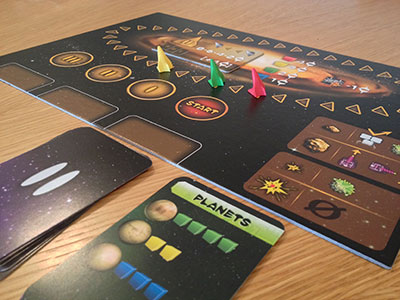Nobody seems to be sure exactly where the phrase “a game of two halves” originally came from. One thing I’m certain of, though, is that it accurately describes my view of Galaxy Trucker. Let me explain.
The Game
The game features two main phases: one in which players construct ships against a time limit, and another in which they fly those ships on short journeys through space. The aim of the game is to pick up valuable goods during the flight, avoid taking too much damage from various cosmic threats, and arrive at the destination sooner than your opponents - all of which activity is rewarded by earning money.
In the standard variant of the game, you play through three rounds, using three different sizes of player board, so the overall structure of a game looks like this: Build a small ship, fly it, build a bigger ship, fly it, build an even bigger ship, fly it and then count up cash and see who wins.
Ship-Building Phase
During the ship-building phase of Galaxy Trucker, players grab square tiles from a central pool and slot them into a spaceship-shaped grid on their player boards. The tiles feature a variety of useful ship components: guns, engines, crew cabins, storage holds, power supplies, shields etc, and must be slotted next to each other so that the connectors depicted on their edges match up.
There are three connector types: single, double and universal, and the rule, in a nutshell, is that you can’t connect a single to a double but anything else is fine.
The time limit is tracked using a sand-timer, which gets flipped over a set number of times (depending on the round). When the timer expires on its final flip, ship-building immediately stops and players move on to the flight phase.
Flight Phase
In the flight phase, players must keep track of their relative positions, which are initially based on who built their ship fastest, second fastest, third fastest, and so on. During the flight, a sequence of Adventure Cards are revealed and players must deal with whatever comes their way.
There are planets to loot, enemies to fight, meteors that threaten to knock chunks out of everyone’s ships and opportunities to fire engines and compete for the lead. Taking the lead has its risks, such as being forced to deal with enemies before your opponents have to, but is generally advantageous, since you get first choice on looting opportunities, and a bigger cash bonus for arriving at the destination first.)
A game of two halves?
I really enjoy the ship-building phase of Galaxy Trucker. It’s a competitive real-time pattern-optimisation / shape-completion puzzle which requires a little bit of speed and dexterity, a touch of memorisation and a good amount of efficiency and rapid-fire prioritisation.
It's especially interesting how players can choose, if they're feeling confident, to flip the sand-timer to its next stage, increasing the pressure on opponents whose progress may be lagging behind. This, combined with the fact that everyone is competing to grab the most desirable tiles from a shared pool, really makes the gameplay interactive and forces players to pay attention to what's going on around them. Overall, it’s a tense, exciting and interesting challenge, one that's a lot of fun.
Then there’s the flight phase. Frankly, it’s just a little bit dull. Sure it does offer some entertaining moments, especially when the dice are rolled to determine where meteors hit, and somebody’s poorly constructed ship gets sheared magnificently in half. But there’s just not very many meaningful or interesting gameplay decisions on offer.
It’s basically a sequence of mostly passively experienced encounters punctuated by the occasional choice of picking up some loot in exchange for losing ground on the flight track, or spending some battery power to fire more engines and compete for the lead.
So, yes, Galaxy Trucker is indeed “a game of two halves.”
Is this a major problem? It depends how you perceive it. I think it helps to consider the flight phase of Galaxy Trucker as being somewhat similar to the end-scoring sequence of a complex Euro game. You probably wouldn’t think about the end-scoring sequence as being part of playing the game itself. It’s just an exercise in tallying up various quantities in order to reach a final score (which indicates how well you played the game).
The flight sequence of Galaxy Trucker is practically equivalent to this. It’s an exercise in putting your newly built ship through a sequence of “tests” in order tally up various quantities (cash rewards) and reach a final amount (which, in essence, indicates how well you built your ship). In other words, the real heart of Galaxy Trucker - the place where the important decision-making meat of the game resides - is the ship-building phase. The flight phase is little more than a mechanical process you go through afterwards in order to evaluate your build and score points.
Closing Comments on Galaxy Trucker
If you’re looking for a competitive, fast-paced, tile-laying puzzle, themed around building spaceships, I’d definitely recommend giving Galaxy Trucker a try. Just don’t go into it expecting some sort of immersive space-journey adventure game, or you might be disappointed.






